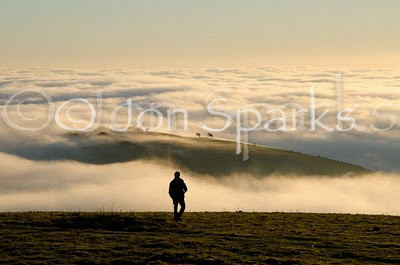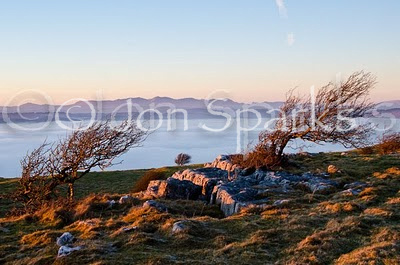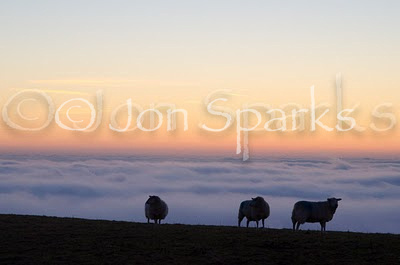

Landscape photography is a nice, slow, contemplative business, isn't it? Well, maybe... sometimes. And then again there are times like last night. I'd spent much of the day delivering greetings cards and postcards to outlets across Cumbria. I'd had clear skies for most of the day but drove into thick fog between Ulverston and Barrow. The fog was clearly spreading as I made my way down to Kents Bank for the last drop of the day, but I had a hunch that I'd get above it on Hampsfell, and I was right. If you don't know Hampsfell, you should; it's one of the lovely limestone ridges around the southern fringe of the Lake District, with wide views over Morecambe Bay in one direction and the high Lakeland fells in the other. I had a walk there in Car-Free Cumbria (hard to get now, contact me if you'd like a copy).
Yesterday I parked near the golf club for the quickest access and within a couple of minutes walking I was starting to emerge above the clouds. But here's the thing. It was almost 3.30 and I knew sunset would be at 4.30 (a few minutes later than almanac time because I was a couple of hundred metres above sea level). I had just an hour and there were photo opportunities in every direction.
Clearly it was going to pay to be fairly quick and decisive with my shooting decisions. I knew that I only had to turn the Mode Dial on my Nikon D7000 to U1 and all the basic settings would be what I want for landscape; I'd then only need to adjust aperture or shutter speed and maybe ISO. The basic problem still remained: every time I stopped to take a shot at Point A I was losing the chance to take a shot at Point B.
Decisions, decisions. The sun was getting low and its acute angle meant the light was changing quickly, and the fog level was fluctuating too. When the light and/or weather is really spectacular there's a fundamental tension between the shots that you can see right in front of you and the (potentially even better?) opportunities that might be waiting just over the hill.
I spent about twenty minutes on Fell End, not right on top but moving around the shoulders of the hill where the ground is steeper. I even took a few shots of someone playing golf (I know, I know, but the light was amazing). In that time the fog dropped a little and the continuation ridge to the south appeared for a few minutes (the only name on the map is Wart Barrow). I even got lucky enough to get a couple of shots with a walker in the foreground.
All the time, though, I knew I wanted to get to the top of Hampsfell proper – about a kilometre to the north – before the sun went down. Not because of summit fever but because I knew from previous visits that it has some lovely limestone outcrops and great views over the Vale of Cartmel to the Coniston Fells. By about ten to four I knew I had to move, and fairly quickly to, to get there in time. I took this at a brisk walk, but couldn't resist stopping for a few quick shots along the way (posing sheep above the clouds, that sort of thing).


By the time I got to the limestone edges it was 4.15. This didn't leave me much time at all to find the best position. The second photo here was taken (according to metadata) at 16.19.35. Within a few more minutes the light on the foreground was losing its edge as the sun almost touched the cloud layer. As it was turning the clouds pink I thought there might be one more shot and I could see a nice lone tree that might make a nice foreground for it–but I had to run to get there before the sun went down.


And that seemed like it was it. Except that as I walked back over Fell End the mist began to creep up and over the ridge and I got a whole series of new shots. And then the only problem was finding my way back down when suddenly visibility was down to 30 or 40 metres.
Moral of the story? I had an hour of the sort of light and conditions that landscape photographers dream of. In that time I got probably 12–15 shots that are real 'keepers', plus minor variants. To me that's a pretty good rate of return. But it was only possible because I was familiar with the camera and had most of the settings sorted in advance. It also helped a lot that I'd been to the location several times before and had a good idea where to head for. And finally, it helped that I wasn't overburdened with gear and could move pretty fast. I think tripods are a great thing and every photographer should have one. But you also have to know when to leave them behind.